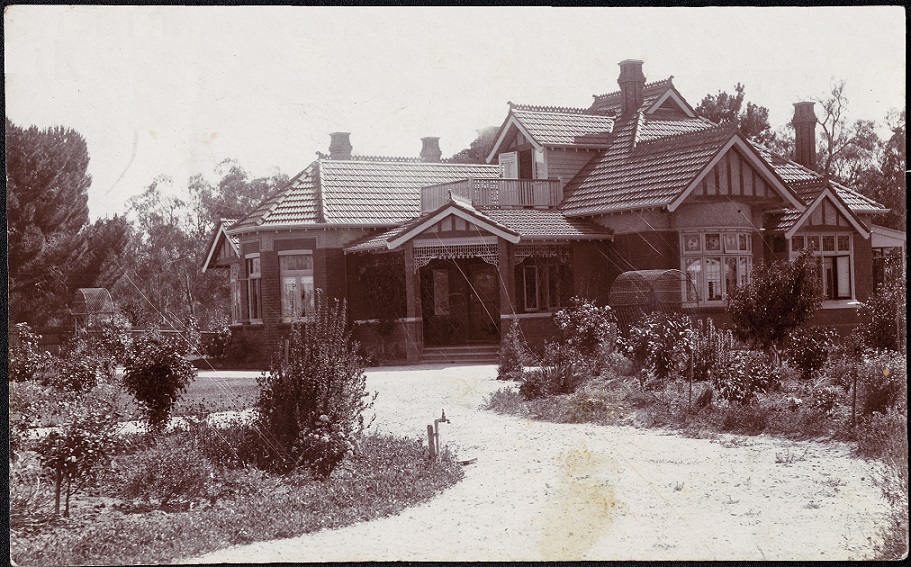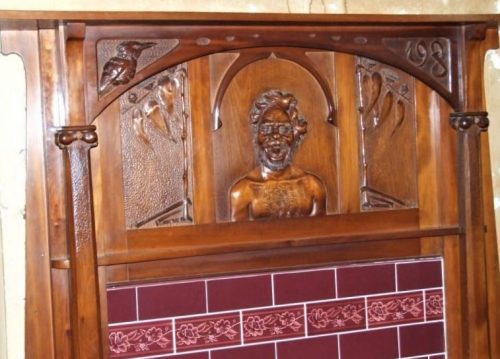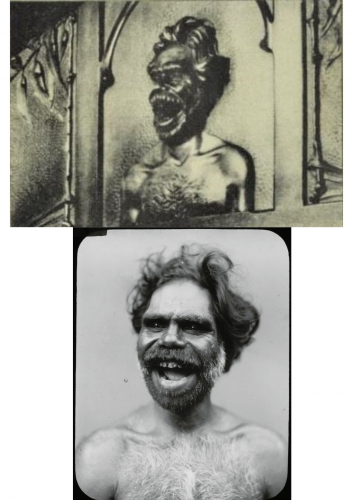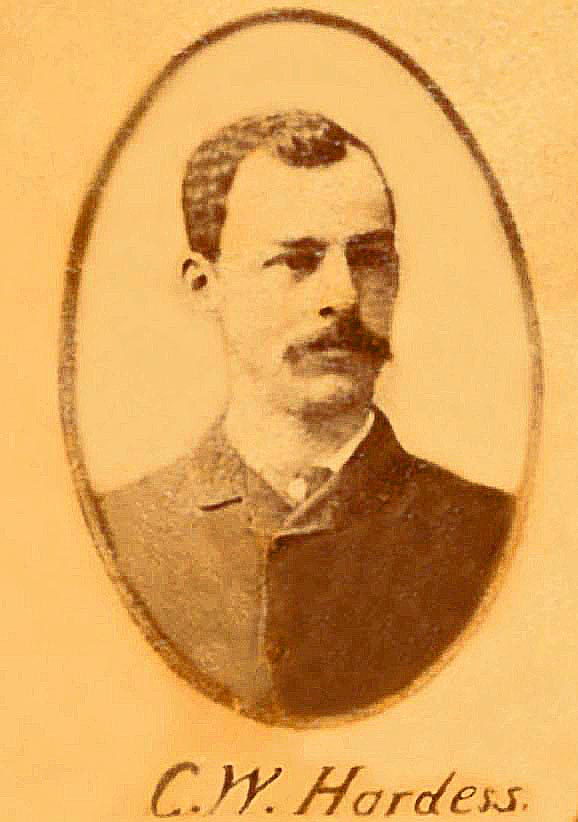I recently stumbled upon a photo of the beautiful home below. This image was scanned by the State Library of Victoria but the cataloguers had not identified the house, the title being merely “House brick with porch and gabled roof, Wangaratta.” I asked the lovely people at the SLV for a scan of the rear of the postcard the image was printed on, and hit the jackpot. On the rear, an undated message addressed to Mrs Akeroid of Brunswick, began with the heading ” “Warra”, Wangaratta” and signed by M Murdoch. This clearly identified the house as ‘Warra’ in Murdoch Road, as I had suspected. From that one discovery (and following down a number of rabbit holes) an important research question has opened up, with the possibility of adding knowledge and context to the collection and recording of First Nation language in the north east of Victoria. This is the first post of two which will explore this question. This post sets the scene of the Murdoch family and tackles the myth of the connection between an iconic piece of house decor and the name of the house.
‘Warra’, Murdoch Rd, Thelma Studios, courtesy of the State Library of Victoria
The image of ‘Warra’ is sadly scratched, but you can make out some detail of the leadlight windows and fretwork around the veranda. Many sources record this home as being built in 1908, which is supported by a carving over one of the mantelpieces. However, the carving is a rather odd rendition of the year and I wouldn’t be surprised if it has been altered. Rate book entries would give a more specific date of the build. Apart from the name of the property, another thing that the SLV cataloguers missed was that the image was printed on a postcard produced by Thelma Studios. The exact date it was taken is open to discussion, however, it is not likely to be much later than 1921 after which Thelma Studios closed as Thomas Courtney left Wangaratta for North Geelong. The garden suggests a time frame within a few years of the house being completed. The arbours are not yet covered and the large shrubs in the right rear might be only three to five years old. This dates the image to around 1910 to 1913 at a best reckoning.
Murdoch’s rose garden, Wangaratta Chronicle, 22 December 1915. This shows the garden in a much more advanced state than the postcard image, giving more credence to a photo date not long after the house was built.
My well worn copy of Old Tales & Tours. You can search my index of this book here.
Edna Harman and Judy Bassett, in their book Old Tales and Tours had an entry on pages 88 and 89 for ‘Warra’ and Mrs Harrington, who was the owner of the house at the time of their visit in the early 1980s. Edna described the house as originally set in four hectares of garden with a driveway forming a crescent, and wrought iron gates that had been moved as the property was subdivided and that sweeping driveway lost.
This is where we get to untangling the inaccuracies surrounding this property. Edna Harman was almost 100% of the time completely accurate with her research. Not only did she speak to many local people about the town’s history on an ongoing basis (my grandmother included), she researched using local newspapers and a huge array of primary source documents. Heritage reports and the sundry heritage databases that exist today, on the other hand, do no primary research, but ‘lift’ their information from other secondary sources, or take their information from cursory reports done in order to get a building listed.* Unfortunately the recording of the listing of ‘Warra’ in the (National) Trust Newsletter of November 1975, page 4, leaves us none the wiser, saying only “A fine example of picturesque house design in the Queen Anne manner, designed and built by Frank Harders of Wangaratta for the solicitor H.A. Murdoch.” Clearly the person who registered ‘Warra’ had not been inside the house! Unfortunately the National Trust plaque at the property also repeats this misinformation about the alleged architect. As Edna pointed out, she thought the architect was Francis Hardess, not Harders – and she was right.**
So who was Hardess? The Wangaratta Heritage Study (volume 4) 2004 does a lot better with their listing for this building, using multiple sources and more detailed architectural notes. It records Francis Hardess and his brother Charles Hardess as brothers-in-law of “Harold” [sic] Murdoch (as does the Victorian Heritage Register), but does not explain how. These men were in fact, brothers of Murdoch’s wife Marion Martha Hardess. Yet Marion does not rate a personal mention in the local Heritage Study or any other heritage reports except as “Harold [sic] Murdoch’s wife said to have been an artist who used the attic rooms as a studio.” Poor Marion. She was likely responsible for the garden and the internal decor given her close connection with the contractors, and yet she has been relegated to the rather ignominious status of un-named wife, leaving her husband and brothers with all the credit. In 1915 Marion donated an oil painting of roses for a raffle in aid of the Belgian Relief Fund and in the same year, the Wangaratta Chronicle described her as “a talented amateur artist” in oils and watercolour, so it seems likely that her studio was used for painting.
A fine example of Gum-nut art nouveau carving at ‘Warra’, likely by Robert Prenzel. See the website of Garry Nash Real Estate for more fabulous images of Warra. tinyurl.com/96nuwb5t
Of particular note in the complex house are the stained glass windows, timber panelling and distinctive carved fireplace mantels. In relation to the unique mantelpieces specifically, Edna goes on to discuss the work of Prussian born Robert Wilhelm Prenzel who created similar Gum-nut Art Nouveau carvings to those seen in ‘Warra’. This point has been picked up in some heritage studies, that the carving of a First Nations man was “thought to be” by Robert Prenzel, or as fact, without supporting evidence.
Top: Pix Magazine, Vol. 5, no. 5, p.37 Bottom: ‘Laughing Man’, by Henry King c1890, Sydney, National Library of Australia
Several examples are available of Prenzel’s portrait carvings of First Nations people. They are very similar to the ‘Warra’ mantelpiece depicting a First Nations man, and the second gumnut Art Nouveau mantelpiece in the home has close parallels in Prenzel’s work. In 1940 Pix magazine interviewed Prenzel. One photo shows a mantelpiece that is almost identical to that in ‘Warra’, except for the expression on the subject’s face. In The Triad magazine in 1923 Prenzel had explained, “I never use models, unless occasionally for a full figure, and then only as a guide for size for my wood.” He said that he found the features of First Nations people interesting, although his characterisation of them was often grotesque, typical of late 19th and early 20th century European society who saw them as anthropological subjects rather than people. This is borne out to a greater extent in Terence Lane’s book on Prenzel’s life and work which used the Prenzel family archive as a primary source. It specifically mentions that the carving shown in Pix was taken from an image by Henry King of Sydney around 1890. The photo is merely titled ‘Australian Aborigine’ or ‘Laughing Man’. That this was anthropology influencing art is further reinforced by the Italian painter Girolamo Nerli’s use of the same photo in a number of portraits. Most importantly, Lane notes in relation to King’s image that “Prenzel … based a whole series of portraits on it, starting with mantelpieces for his own home and that of H.A. Murdoch in Wangaratta.” “No two versions are the same and there are marked departures from the source, particularly in the rendering of the age and expression of the subject.“
Some local stories have suggested that the man depicted in the mantelpiece carving was a local individual named ‘Warra’. It is clear that this is a myth. It is also clear that the mantelpiece in ‘Warra’ IS a work by Robert Wilhelm Prenzel, but that it held no significance in relation to the identity of the man depicted, or the name of the Murdoch’s house. But what was the reason behind the house name chosen by the Murdochs? I want to establish the motivation of the Murdochs in the naming of the house and the sentiments that they may have held in relation to First Nations People, and specifically, if the name ‘Warra’ itself was representative of a real person.
Now getting back to the Murdochs to round off the story of the house, Mrs Marion Murdoch was born in North Melbourne in January 1874 to Mary Ann (nee McCarthy) and George Matthew Hardess, and was the couple’s only daughter. Her father George was an early Melbourne photographer who was on the council of the Photographic Society of Victoria in 1860. He was also for many years the superintendent of Hotham School of Arts. One brother was Frank, or Francis McCarthy Hardess, the reputed architect of ‘Warra’. However, Frank only ever described himself on electoral rolls as a carpenter or contractor. In the nineteenth century many builders did act as architects, but there doesn’t seem to be any information from Edna as to why she thought he was the architect. Possibly the house was noteworthy enough to have a local newspaper article at the time it was built which would explain this, and I will attempt to search for such an article. Frank also never had a permanent residence in Wangaratta as the National Trust plaque suggests. He likely did live there for a short time during the house construction. It is however, notable that the Australian Architectural Index by Miles Lewis has only one entry for a Frank Harders [sic] who allegedly built ‘Warra’, citing the National Trust as the source, and no other buildings are credited to any Hardess family member.
Portrait of Charles Hardess, June 1887, kindly contributed by Ray Brown, from his website on colonial stained glass craftsmen Ferguson & Urie.
Another brother of Marion was Charles William Hardess who described himself between 1899 and 1909 as a glass stainer, then a leadlight artist until at least 1919, and then the non descript “manufacturer”, although his 1949 probate file records him as a “stained glass artist”. Ray Brown has researched the role of Charles Hardess’ as a stained glass artist with the firm Ferguson & Urie. A third brother, Arthur Ernest, described himself as having a similarly non descript occupation of “clerk” between 1903 and 1937 but in 1939 dropped in that he was a glazier. Edna mentioned that the leadlight windows were “thought to have been crafted” by Charles Hardess when he was in business as Hardess and Lording. The stained glass windows in one of the rooms are of violets and have been rendered in the familiar women’s suffrage colours of green, white and violet. Marion was only 17 years old when the Women’s Suffrage Petition was created in 1891, but her sister-in-law Janet Gilchrist Hardess, wife of Charles, signed the petition, although her name has been indexed as Harders. For views of the leadlight windows when the house was sold, pop over to Gary Nash Real Estate.
Another problem with the heritage studies and reports published about this property is the information about the original owners. The Wangaratta Heritage Study records the owner as Harold Murdoch when it was in fact, Henry Alexander Murdoch. He wasn’t known as Harold either. He was known as Harry, and this would be evident to anyone using a primary source. This error, and several others in the story of this house also appear in the Victorian Heritage Database. They suggest that the reliability of sources such as heritage databases are dubious indeed. A death year of 1935 is attributed to Harry, but he actually died in July 1934 and was buried in Wangaratta cemetery. All the inaccuracies surrounding this property are a classic example of an old and unreliable secondary source (the National Trust registration in this case), never being interrogated, but quoted for decades without question.
Marion passed away in 1947 and the house was in the hands of Frederick Charles Willcox, a law clerk, and his wife Winifred, by 1949. But one question remains unanswered. When and how did ‘Warra’ obtain it’s name? We know that the man depicted in the mantelpiece has no relevance to the house name. Rather, he was a stylised representation of what European Australians thought was a culture long gone. There are importantly, several clues in the activities of the Murdoch family that allow us to use this house as a springboard to drill deeper and open up this discussion. The research has important implications for the context in which First Nations culture and language in the north east of Victoria was recorded. In the next post on this subject I will discuss the Murdoch family and their movements in the sphere of First Nations culture, after assistance from Jacqui Durrant (Life on Spring Creek) and Megan Carter (Dhudhuroa and Waywurru Ancestors).
*It would be good to know how the National Trust sourced their information. Perhaps they were given information from locals, and were not in a position to do their own surveys, then being at the mercy of inaccurate reports and dodgy hand writing. The listing however, clearly only mentions the exterior of the house and is not detailed enough for a survey of any substance to have been done. Due to Covid restrictions I have not been able to access National Trust file no.2695 Survey minutes 4 Sep. 1975 for ‘Warra’.
** The Victorian Heritage Register entry for ‘Warra’ was last updated in 1999 and contains substantial further descriptions of the building and limited mentioned of the interior. It claims the mantelpieces as the work of Robert Prenzel with no citation. Although it correctly names the Hardess brothers, it also records the achitect as F. Hardens, another error.
Update: 27 June 2022 -Other images of ‘Warra’ taken by John T Collins in 1978 have recently been digitised by the State Library of Victoria. They show the two art nouveau fireplaces as well as an exterior image.












I found an interesting article with several historical references to the word “Warra” which seems like a likely explanation for the popularity of the the word among the non-indigenous : (https://www.eorapeople.com.au/uncategorized/warra-warra-wai-2/}
“‘Their countenance bespoke displeasure; they threatened us, and discovered hostile intentions, often crying to us, Warra warra wai,’ wrote the young Scots artist Sydney Parkinson (c1745-1771) who accompanied Cook on his first landing.
These words, meaning ‘go away’ or ‘begone’, were the first ever spoken to the English colonists by the Indigenous inhabitants of southeastern Australia. And, it seems, spread widely. ”
BTW, I lived in the home as “artist is residence” for over a year and painted a number of interiors. Still haven’t got it out of my system – as an inspiration. See some of the paintings here: https://scottwilmotbennett.com/day-lights-index/
Thanks for your information Scott, and for sharing your fabulous artwork focussing on the play of light inside Warra. Those leadlight windows are beautiful and intriguing. I do have a theory and some information for their design inspiration but sadly it won’t be published.
Thanks for dropping by. 🙂
Hi Jenny,
What a fascinating article! We would love to talk with you about Warra. We are the current owners and have done quite a lot of research into the house and previous owners. We may have some answers to some of your questions. You are researching some things we have been unable to find any answers to and would love to know more about.
Kind Regards
Robyn and Guy
Thanks for your contact Robyn and Guy. I’ll email you. 🙂
Most everything of Marion’s was subsumed by her husband’s name. Even her name and initials.
Marion’s visiting card is labelled ‘Mrs. H. A. Murdoch’ (and names the property ‘Warra’ on the bottom left-hand side). I have a copy if you’d like to see it.
Hi David,
Thanks for dropping by. I would indeed be interested to see Marion’s visiting card. You likely know it was the norm for a married woman to be known by her husband’s name as if she was one of his posessions. It was only when he died that she could use her own name or intitials. It makes it very difficult to research women who were married to prominent men.
You can use the contact form to message me if you like.
Kind regards,
Jenny